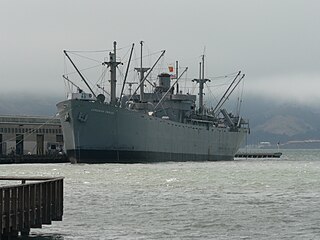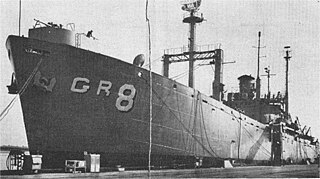Related Research Articles

SS Jeremiah O'Brien is a Liberty ship built during World War II and named after the American Revolutionary War ship captain Jeremiah O'Brien (1744–1818).

The Borscht Belt, or Yiddish Alps, is a region which was noted for its summer resorts that catered to Jewish vacationers, especially residents of New York City. The resorts, now mostly defunct, were located in the southern foothills of the Catskill Mountains in parts of Sullivan and Ulster counties in the U.S. state of New York, bordering the northern edges of the New York metropolitan area.

The United States Navy maintains a number of its ships as part of a reserve fleet, often called the "Mothball Fleet". While the details of the maintenance activity have changed several times, the basics are constant: keep the ships afloat and sufficiently working as to be reactivated quickly in an emergency.

Suisun Bay is a shallow tidal estuary in Northern California. It lies at the confluence of the Sacramento River and San Joaquin River, forming the entrance to the Sacramento–San Joaquin River Delta, an inverted river delta. To the west, Suisun Bay is drained by the Carquinez Strait, which connects to San Pablo Bay, a northern extension of San Francisco Bay. Grizzly Bay forms a northern extension of Suisun Bay. Suisun Bay is between Contra Costa County to the south and Solano County to the north.

The National Defense Reserve Fleet (NDRF) consists of ships of the United States, mostly merchant vessels, that have been mothballed but can be activated within 20 to 120 days to provide shipping during national military emergencies, or non-military emergencies such as commercial shipping crises.

A reserve fleet is a collection of naval vessels of all types that are fully equipped for service but are not currently needed; they are partially or fully decommissioned. A reserve fleet is informally said to be "in mothballs" or "mothballed". In earlier times, especially in British usage, the ships were said to be "laid up in ordinary".

Terence Patrick O'Neill was a British photographer, known for documenting the fashions, styles, and celebrities of the 1960s. O'Neill's photographs capture his subjects candidly or in unconventional settings.

The Jackling House was a mansion in Woodside, California, designed and built for copper mining magnate Daniel Cowan Jackling and his family by noted California architect George Washington Smith in 1925.
Grossinger's Catskill Resort Hotel was a resort in the Catskill Mountains in the Town of Liberty, near the village of Liberty, New York. It was a kosher establishment that catered primarily to Jewish clients from New York City. Under the direction of hostess Jennie Grossinger, it became one of the largest Borscht Belt resorts. After decades of activity and notable guests, it closed in 1986. Most of the buildings on site had been demolished by 2018; however, a few remained in decrepit condition, and were destroyed in a fire in 2022.

Night photography is the capturing of images outdoors between dusk and dawn. Night photographers generally have a choice between using artificial lighting and using a long exposure, exposing the shot for seconds, minutes, or hours in order to capture enough light to record an image. With the progress of high-speed films, higher-sensitivity digital sensors, wide-aperture lenses, and the ever-greater power of urban lights, night photography is increasingly possible using available light.

The Concord Resort Hotel ) was a resort in the Borscht Belt of the Catskills, known for its large resort industry in the 1950s, 1960s and 1970s. Located in Kiamesha Lake, New York, United States, the Concord was the largest resort in the region and was also one of the last to finally close in 1998, long after the others closed. At the Concord, there were over 1,500 guest rooms and a dining room that sat 3,000; the resort encompassed some 2,000 acres (8.1 km2). The resort was a kosher establishment, catering primarily to Jewish vacationers from the New York City area, and it was more lavish in decor and activities than comparable large Catskill resorts.
San Francisco Baykeeper is a nonprofit environmental advocacy organization that uses science and the law to protect, preserve, and enhance the health of the ecosystems and communities that depend upon the San Francisco Bay, the San Francisco Bay-Delta Estuary, and its watershed. SF Baykeeper is the only organization, governmental or non-profit, that regularly patrols the Bay by boat and drone to document sources of pollution.

USS Menifee (APA-202) was a Haskell-class attack transport that saw service with the US Navy in World War II and the Korean War.

USS Interceptor (AGR-8/YAGR-8) was a Guardian-class radar picket ship acquired by the US Navy in 1955, from the "mothballed" reserve fleet. She was reconfigured as a radar picket ship and assigned to radar picket duty in the North Pacific Ocean as part of the Distant Early Warning Line.

The Suisun Bay Reserve Fleet colloquially known as the mothball fleet, is located on the northwest side of Suisun Bay in Benicia, California. The fleet is within a regulated navigation area that is about 4+1⁄2 miles long and 1⁄2 mile (0.80 km) wide. It begins just north of the Union Pacific Railroad Bridge and runs northeast, parallel to the shoreline. Water depths range from about 46 feet at Mean Lower Low Water (MLLW) at the foot of the anchorage, to about 26 feet (8 m) MLLW at the shallowest berths towards the northern end of the anchorage. As of February 2024, seven ships remain in the fleet.

Charles Robert Gatewood was an American photographer, writer, videographer, artist and educator, who lived and worked in San Francisco, California.
Marisa Scheinfeld is an American artist, photographer and educator currently living in New York. Marisa's work is highly motivated by her interest in ruins and the histories embedded within them. Her projects have taken her from the United States to Israel, Poland, the Czech Republic, Slovakia and India. Her photographic projects and books are among the collections of Yeshiva University Museum, Lynn Kroll, The Simon Wiesenthal Center in Los Angeles, CA, The La Jolla Athenaeum in La Jolla, CA, The Magnes Collection of Jewish Art and Life The Edmund and Nancy K. Dubois Library at the Museum of Photographic Arts in San Diego, CA and The International Raoul Wallenberg Foundation in New York, NY.
Nancy Rexroth is an American photographer noted for her pioneer work utilizing the Diana camera. In 1977, she published Iowa – the first printed monograph of work completed with a plastic camera.
Jennie Grossinger was a Jewish Austrian-American hotel executive and philanthropist. She is considered one of the great hostesses of 20th-century. She was the hostess of one of the largest Borscht Belt resorts, Grossinger's Catskill Resort Hotel. Beginning from the 1930s, she started to give up many of her business responsibilities, and started to devote herself to philanthropic causes. In her life, she had received several honors and awards for her philanthropic and social services.
Cape Newenham was a type C1-B small cargo ship built for the United States Maritime Commission during World War II. The ship was completed on 24 April 1943, and made a maiden voyage from San Francisco to Brisbane, Port Moresby, and Gladstone, before returning to Oakland, California in August, where Moore Dry Dock Company completed conversion to a troop transport in December.
References
- ↑ Gray, Billy. "Summer Bummer: Remember the Catskills". Guest of a Guest. Retrieved 24 August 2011.
- ↑ Hibble, Anna Marie (7 October 2010). "Woodside historic mansion is history: Steve Jobs gets green light to build version 2.0". San Francisco Chronicle. Retrieved 24 August 2011.
- ↑ Nestor, James (19 Aug 2007). "The Art of Urban Exploration". San Francisco Chronicle. Retrieved 24 August 2011.
- ↑ Haeber, Jonathan (2 July 2002). "Letters to the Editor: Anti-War 'Activists' Do Not Live Up to Their Title". Daily Californian. Archived from the original on 16 March 2012. Retrieved 24 August 2011.
- ↑ "Jon Haeber on Exploring Built Environment Jan 6 2011". Puzzling Evidence TV. Retrieved 24 August 2011.
- ↑ University of Massachusetts Amherst Department of History Alumni Profiles, http://www.umass.edu/history/ph/alumni.html
- ↑ Seldan, Kelly. "Gone Too Soon – Photojournalism of Neverland at Night by Jonathan Haeber and Scott Haefner". Archived from the original on 31 March 2012. Retrieved 24 August 2011.
- ↑ Elmer-DeWitt, Philip. "Inside Steve Jobs' tear-down mansion". CNN Money. Retrieved 24 August 2011.
- ↑ Poletti, Therese. "Steve Jobs's old manse to be torn down". MarketWatch. Retrieved 24 August 2011.
- 1 2 "Grossinger's: City Of Refuge And Illusion" . Retrieved 24 August 2011.
- ↑ York, Jessica A (25 Jun 2011). "Mothball Fleet: Ghost Fleet Adventure" (PDF). Oakland Tribune. Retrieved 24 August 2011.
- ↑ Bowe, Rebecca (5 July 2011). "Ghost Fleet Wanderers: How three nighttime photographers snuck aboard the abandoned ships of Suisun Bay". San Francisco Bay Guardian. Retrieved 24 August 2011.
- ↑ "The Approval Matrix: Week of June 27, 2011". New York Magazine. Retrieved 24 August 2011.
- ↑ Frazer, Andy. "Jonathan Haeber". Night Photography by Andy Frazer. Retrieved 24 August 2011.
- ↑ Guydish, Mark (22 Aug 2011). "Calif. native keeping track of station history". Wilkes-Barre Times Leader. Retrieved 24 August 2011.[ permanent dead link ]
- ↑ York, Jessica A (23 Jun 2011). "In the heart of giants: Urban explorers delve into Mothball Fleet ships". San Jose Mercury News. Retrieved 24 August 2011.
- ↑ "Pabco Roofing". U.C. Berkeley Graduate School of Journalism. Retrieved 24 August 2011.